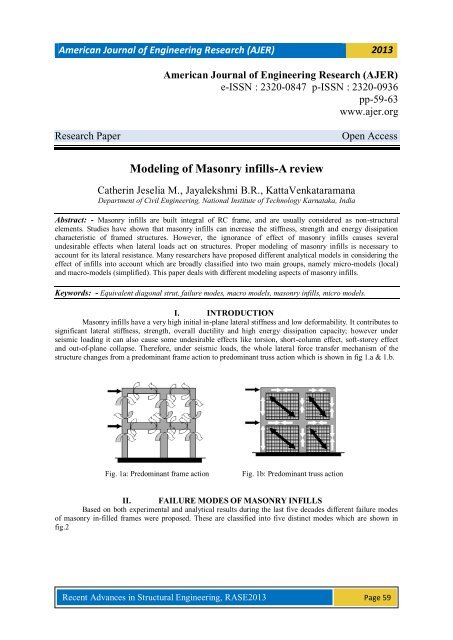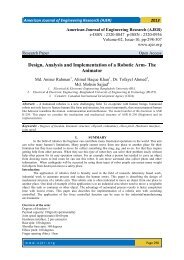Modeling of Masonry infills-A review - American Journal of ...
Modeling of Masonry infills-A review - American Journal of ...
Modeling of Masonry infills-A review - American Journal of ...
You also want an ePaper? Increase the reach of your titles
YUMPU automatically turns print PDFs into web optimized ePapers that Google loves.
<strong>American</strong> <strong>Journal</strong> <strong>of</strong> Engineering Research (AJER) 2013<strong>American</strong> <strong>Journal</strong> <strong>of</strong> Engineering Research (AJER)e-ISSN : 2320-0847 p-ISSN : 2320-0936pp-59-63www.ajer.orgResearch PaperOpen Access<strong>Modeling</strong> <strong>of</strong> <strong>Masonry</strong> <strong>infills</strong>-A <strong>review</strong>Catherin Jeselia M., Jayalekshmi B.R., KattaVenkataramanaDepartment <strong>of</strong> Civil Engineering, National Institute <strong>of</strong> Technology Karnataka, IndiaAbstract: - <strong>Masonry</strong> <strong>infills</strong> are built integral <strong>of</strong> RC frame, and are usually considered as non-structuralelements. Studies have shown that masonry <strong>infills</strong> can increase the stiffness, strength and energy dissipationcharacteristic <strong>of</strong> framed structures. However, the ignorance <strong>of</strong> effect <strong>of</strong> masonry <strong>infills</strong> causes severalundesirable effects when lateral loads act on structures. Proper modeling <strong>of</strong> masonry <strong>infills</strong> is necessary toaccount for its lateral resistance. Many researchers have proposed different analytical models in considering theeffect <strong>of</strong> <strong>infills</strong> into account which are broadly classified into two main groups, namely micro-models (local)and macro-models (simplified). This paper deals with different modeling aspects <strong>of</strong> masonry <strong>infills</strong>.Keywords: - Equivalent diagonal strut, failure modes, macro models, masonry <strong>infills</strong>, micro models.I. INTRODUCTION<strong>Masonry</strong> <strong>infills</strong> have a very high initial in-plane lateral stiffness and low deformability. It contributes tosignificant lateral stiffness, strength, overall ductility and high energy dissipation capacity; however underseismic loading it can also cause some undesirable effects like torsion, short-column effect, s<strong>of</strong>t-storey effectand out-<strong>of</strong>-plane collapse. Therefore, under seismic loads, the whole lateral force transfer mechanism <strong>of</strong> thestructure changes from a predominant frame action to predominant truss action which is shown in fig 1.a & 1.b.Fig. 1a: Predominant frame actionFig. 1b: Predominant truss actionII. FAILURE MODES OF MASONRY INFILLSBased on both experimental and analytical results during the last five decades different failure modes<strong>of</strong> masonry in-filled frames were proposed. These are classified into five distinct modes which are shown infig.2Recent Advances in Structural Engineering, RASE2013 Page 59
<strong>American</strong> <strong>Journal</strong> <strong>of</strong> Engineering Research (AJER) 2013square infill to d/11 for an infill having a side’s ratio <strong>of</strong> 5 to 1, where‘d’ is the length <strong>of</strong> the masonry infill.Stafford Smith[12] discussed about the interaction between frame and infill, and developed a set <strong>of</strong> empiricalcurves that relate the stiffness parameter to the effective width <strong>of</strong> an equivalent strut.By using Smith’s relative stiffness parameter, Mainstone [13] proposed an empirical relation betweenthe effective width <strong>of</strong> an equivalent strut and Stafford Smith′s stiffness parameter. This relation results in alower value <strong>of</strong> effective width <strong>of</strong> diagonal strut than that given by Stafford Smith′s model. Liauw andLee[14]extended the study <strong>of</strong> diagonal strut for the masonry infilled frames with and without openings, andconcluded that the position <strong>of</strong> opening greatly affected the strength and stiffness <strong>of</strong> the <strong>infills</strong>. Hendry[15] alsopresented the equivalent strut width as half the width proposed by Smith. Liauw and Kwanstudied bothexperimentally and analytically the behaviour <strong>of</strong> non-integral infilled frames considering the nonlinearities <strong>of</strong>the material and the structural interface.Fig.3a Six-strut model for masonry-infill in framestructures (Chrysostomou 2002)Fig.3b Proposed masonry infilled steel frame model(El – Dakhakhni 2003)Paulay and Preistley[16] pointed out that a high value <strong>of</strong> strut width will result in a stiffer structure, andtherefore a higher seismic response. And they proposed the width <strong>of</strong> diagonal strut as 0.25 times the diagonallength <strong>of</strong> the strut. Mehrabi et al.[17] had found that Mainstone& Weeks model significantly underestimates thelateral stiffness <strong>of</strong> the uncracked RC sections. Chrysostomou et al.[18]proposed a model with six compressioninclined struts as shown in fig 3.a Three parallel struts in each diagonal direction, and the <strong>of</strong>f-diagonal oneswere positioned at critical locations along the frame members. These locations are specified by parameter α,which represents a fraction <strong>of</strong> the length or height <strong>of</strong> a panel.Recent Advances in Structural Engineering, RASE2013 Page 61
<strong>American</strong> <strong>Journal</strong> <strong>of</strong> Engineering Research (AJER) 2013El- Dakhakhni[19] proposed a simple nonlinear macro-model in which each masonry panel was replaced bythree struts (one diagonal and two <strong>of</strong>f-diagonal) as shown in fig 3.b. with nonlinear force-deformationcharacteristics. Crisafulli& Carr [20] proposed a new macro-model for the evaluation <strong>of</strong> the global response <strong>of</strong>the structure based on a multi-strut formulation. For compressive and shear behavior <strong>of</strong> masonry model, fournode panel element was implemented and a shear spring in each direction as shown in fig 3.c. Amato et al [21]proposed that equivalent strut, when modeled as a concentric element did not give evidences <strong>of</strong> the local effectsand hence evaluated it eccentrically. The various formulae given by researchers to calculate the width <strong>of</strong>equivalent diagonal strut is given in table 1. Rodrigues et al.[22] proposed an improved, equivalent bi-diagonalcompression strut model with a central strut element as shown in fig. 3.d. Samoila[23] applied the variousexpressions <strong>of</strong> width <strong>of</strong> equivalent diagonal strut given by researchers to a single-bay, single-storey frame forsix different modeling possibilities.Recent Advances in Structural Engineering, RASE2013 Page 62
<strong>American</strong> <strong>Journal</strong> <strong>of</strong> Engineering Research (AJER) 2013IV. CONCLUSIONSThe <strong>review</strong> <strong>of</strong> the current practice as applied in modeling <strong>of</strong> masonry <strong>infills</strong> has led to the following broadconclusions by various researchers. The masonry <strong>infills</strong>, although do not interfere in the vertical load resisting system for the RC framestructures, they significantly affect the lateral load-resisting system <strong>of</strong> the same. Formulation given by Paulay and Priestley 16 for equivalent diagonal strut is the simplest <strong>of</strong> all the methods. Indian code does not consider the position or amount <strong>of</strong> infill present in the structure, whereas Euro codegives importance to the masonry in the first storey but the results <strong>of</strong> the Indian code are better compared toEuro code.REFERENCES[1] D.V.Mallick and R.T Severn, TheBehavior <strong>of</strong> Infilled Frames under Static Loading, Proc. <strong>of</strong> ICE,39(113), 1967, 639-656.[2] J.W.Axley and V.V.Bertero, Infill Panels: Their Influence on Seismic Response <strong>of</strong> Buildings, EERC,University <strong>of</strong> California, Berkeley, CA, Rep. UCB/EERC-79/28. 1969[3] T.C.Liauw and K.H. Kwan, Nonlinear behaviour <strong>of</strong> non-integral infilled frames, Computers & structures,18, 1984,551-560.[4] M. Dhanasekar and A.W. Page,Influence <strong>of</strong> brick masonry infill properties on the behavior <strong>of</strong> infilledframes, Proc. <strong>of</strong> ICE, Part 2, 1986,593-605.[5] S.Sk. Ali and A.W. Page, Finite Element Model for masonry subjected to concentrated loads, The <strong>Journal</strong><strong>of</strong> Structural Engineering, 114(8), 1988, 1761-1784.[6] P.G.Asteris,A New Method <strong>of</strong> Analysis for <strong>Masonry</strong> Infilled Frames, SEWC 2002, Yokohama,Japan,2002.[7] A.K. Ghosh and M.J.Amde, Finite element analysis <strong>of</strong> Infilled Frames, The <strong>Journal</strong> <strong>of</strong> StructuralEngineering, 128(7), 2002,881-889.[8] D. Das and C.V.R.Murty, Brick masonry <strong>infills</strong> in seismic design <strong>of</strong> RC frame buildings: Part - 2Behavior, The Indian Concrete <strong>Journal</strong>, 78(7), 2004, 39-44.[9] S. V. Polyakov,On the interaction between masonry filler walls and enclosing frame when loaded inplane <strong>of</strong> the wall, Earthquake Engineering, Earthquake Research Institute, San Francisco, 1960.[10] M. Holmes,Steel frames with brick work and concrete infilling”, Proc. ICE, Paper No. 6501, 1961, 473-478.[11] B.S. Smith., Lateral Stiffness <strong>of</strong> Infilled Frames, <strong>Journal</strong> <strong>of</strong> Structural Division, Proc. <strong>of</strong> ASCE, 114,1962, 183-199.[12] B.S. Smith and C. Carter, A Method <strong>of</strong> Analysis for Infilled Frames, Proc. ICE, 44, 1969, 31-48.[13] R.J. Mainstone, On the stiffness and strength <strong>of</strong> infilled frames,” Proc. <strong>of</strong> the ICE, 1971, 57-90.[14] T.C. Liauw and S.W. Lee, On the behaviour and analysis <strong>of</strong> multi-storey infilled frames subject to lateralloads, Proc. <strong>of</strong> the ICE, Part 2, 1977,641- 656.[15] A.W. Hendry, Structural brickwork, Macmillan, London, 1981.[16] T.Paulay and M.J.N. Priestley, Seismic Design <strong>of</strong> Concrete and <strong>Masonry</strong> Buildings, John Wiley & SonsInc., New York, USA, 1992.[17] A.B.Mehrabi, P.B.Shing, M. Schuller, and J. Noland, Experimental evaluation <strong>of</strong> masonry-infilled RCframes, <strong>Journal</strong> <strong>of</strong> Structural Engineerin., 122(3), 1996,228-237.[18] C.Z.Chrysostomou, P.Gergely, and J.F. Abel, A Six-Strut Model for Nonlinear Dynamic Analysis <strong>of</strong>Steel Infilled Frames, International <strong>Journal</strong> <strong>of</strong> Structural Stability and Dynamics, 2(3), 2002, 335-353.[19] W.W. El-Dakhakhni, M.Elgaaly, and A. A. Hamid, Three-Strut Model for Concrete <strong>Masonry</strong>-InfilledSteel Frames, <strong>Journal</strong> <strong>of</strong> Structural Engineering, 129(2), 2003,177–185.[20] F.J. Crisafulli, and A.J. Carr, Proposed Macro-Model for the Analysis <strong>of</strong> Infilled Frame Structures,Bulletin <strong>of</strong> the New Zealand Society for Earthquake Engineering, 40(2), 2007, 69-77.[21] G. Amato, M. Fossetti, L.Cavaleri, M.Papia, An Updated Model <strong>of</strong> Equivalent Diagonal Strut for InfillPanels, Euro code 8, Perspectives from the Italian Standpoint Workshop, 2009,119-128.[22] H. Rodrigues, V. Humberto, and A.B. Costa, Simplified Macro-Model for Infill <strong>Masonry</strong> Panels, <strong>Journal</strong><strong>of</strong> Earthquake Engineering, 14, 2010, 390–416.[23] D. Samoila, Analytical <strong>Modeling</strong> <strong>of</strong> <strong>Masonry</strong> Infills, Civil Engineering & Architecture, 55(2), 2012, 127–136.Recent Advances in Structural Engineering, RASE2013 Page 63



